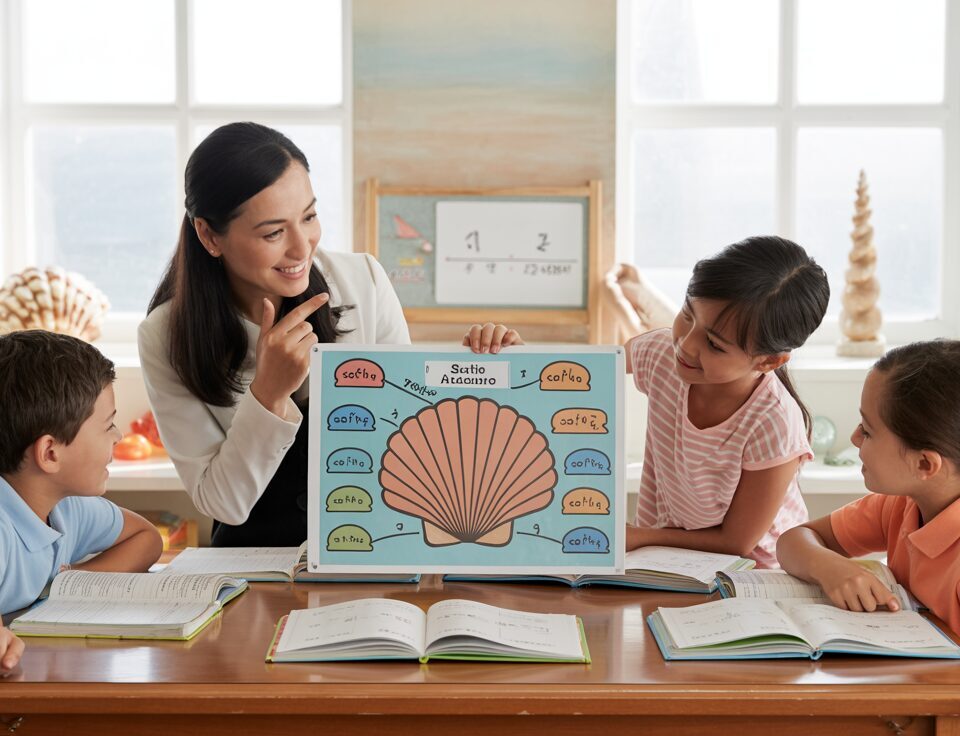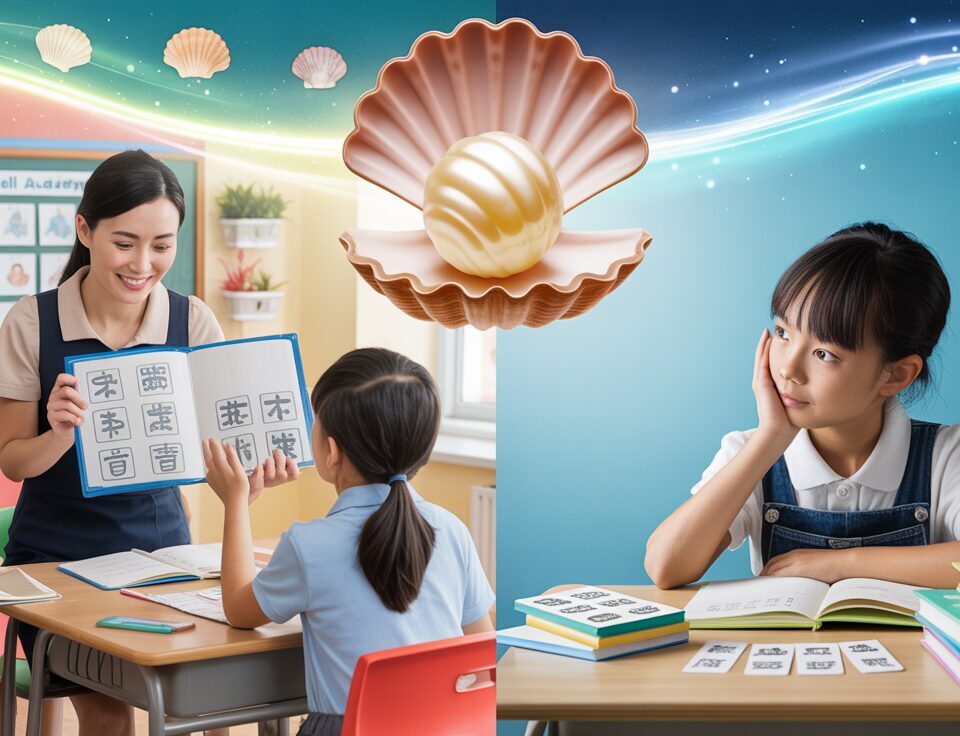
Complete Guide to Chinese Tuition for Primary School Students in Singapore
October 7, 2025
DIY Chinese Word-Root Flashcards: A Step-by-Step Tutorial for Primary School Success
October 8, 2025Table Of Contents
- Introduction: The Challenge of Chinese Vocabulary
- Understanding the Chinese Word Root Method
- 5 Key Benefits of the Word Root Approach for PSLE Students
- How to Implement the Word Root Method in Daily Learning
- 10 Common Chinese Word Roots Every Student Should Know
- Practical Examples: Expanding Vocabulary Through Word Roots
- Teaching Strategies for Parents and Educators
- The Seashell Method: Integrating Word Roots into Holistic Learning
- Conclusion: Beyond Vocabulary to True Language Mastery
PSLE Prep Hack: Master 2000+ Chinese Words Easily With The Word Root Method
Is your child struggling to memorize Chinese characters for their PSLE? Do they feel overwhelmed by the seemingly endless vocabulary list? You’re not alone. Many Singapore students find Chinese language preparation challenging, especially when it comes to building sufficient vocabulary for examination success. However, there’s a powerful technique that transforms this daunting task into an achievable goal: the Chinese Word Root Method.
Unlike rote memorization that often leads to frustration and burnout, the Word Root Method offers a systematic approach that helps students understand how Chinese characters are constructed. By learning the fundamental building blocks of Chinese vocabulary, students can quickly expand their word bank to over 2000 words – more than enough to excel in their PSLE Chinese examinations.
At Seashell Academy by Suntown Education Centre, we’ve integrated this powerful technique into our curriculum, allowing our students to not only memorize characters more efficiently but also develop a deeper understanding and appreciation of the Chinese language. In this comprehensive guide, we’ll explore how the Word Root Method works, its benefits for primary school students, and practical strategies to implement this approach in your child’s learning journey.
Understanding the Chinese Word Root Method
The Chinese Word Root Method is based on a fundamental insight about the Chinese language: most characters aren’t random collections of strokes but are built from smaller meaningful components called ‘word roots’ or ‘字根’ (zì gēn). These word roots carry semantic meaning and appear consistently across multiple characters.
Unlike English, where words are formed from letters that generally don’t carry meaning individually, Chinese characters are built from components that often provide clues to the character’s meaning or pronunciation. By understanding these building blocks, students can systematically decode unfamiliar characters and make educated guesses about their meanings.
For example, the word root ‘水’ (shuǐ), meaning ‘water’, appears in many water-related characters: ‘洗’ (xǐ, to wash), ‘海’ (hǎi, sea), ‘游’ (yóu, to swim), and ‘湖’ (hú, lake). Learning one word root can immediately help students connect with and remember multiple characters, creating an exponential growth in vocabulary acquisition.
This method transforms Chinese learning from memorizing thousands of seemingly unrelated characters to understanding a much smaller set of word roots (approximately 200) and learning how they combine to form characters. It’s similar to how understanding prefixes, roots, and suffixes in English can help decode unfamiliar words.
5 Key Benefits of the Word Root Approach for PSLE Students
The Word Root Method offers several advantages that are particularly beneficial for primary school students preparing for their PSLE Chinese examinations:
1. Exponential Vocabulary Growth
Rather than learning characters in isolation, students who master 200 common word roots can recognize and understand over 2,000 characters. This exponential growth in vocabulary provides a significant advantage in comprehension tasks during the PSLE.
2. Improved Character Retention
When students understand the logical structure of characters, they retain them much longer than through rote memorization. The meaningful connections between word roots and characters create stronger memory associations, reducing the need for constant revision.
3. Enhanced Comprehension Skills
Students equipped with word root knowledge can make educated guesses about unfamiliar characters in reading comprehension passages, improving their ability to understand texts even when they contain vocabulary beyond their current level. This critical skill can make the difference between passing and excelling in the PSLE Chinese paper.
4. Reduced Learning Frustration
The systematic nature of the Word Root Method transforms Chinese learning from an overwhelming task to a logical puzzle, significantly reducing frustration and building confidence. Students begin to see patterns rather than chaos, which nurtures a more positive attitude toward Chinese language learning.
5. Deeper Language Appreciation
Understanding word roots gives students insights into the cultural and historical aspects of Chinese characters. This deeper connection to the language often sparks genuine interest and appreciation, transforming learning from exam-focused drilling to meaningful cultural exploration.
How to Implement the Word Root Method in Daily Learning
Integrating the Word Root Method into your child’s learning routine doesn’t require a complete overhaul of their study habits. Here are practical steps to implement this approach effectively:
Start with Common Semantic Radicals
Begin by introducing the most frequently used semantic radicals (meaning components) such as ‘氵’ (water), ‘木’ (wood), ‘口’ (mouth), ‘心’ (heart/mind). Create flashcards with the radical, its meaning, and 2-3 example characters containing that radical. Spend 10-15 minutes daily reviewing these foundations.
Create Word Family Charts
Help your child create visual charts grouping characters by their common word roots. For instance, a chart for the ‘木’ (wood) radical might include: ‘树’ (tree), ‘桌’ (table), ‘椅’ (chair), and ‘森’ (forest). These visual connections reinforce the relationships between characters and strengthen memory associations.
Practice Character Decomposition
When encountering new characters, guide your child to break them down into their component parts. Ask questions like: “Which parts of this character have you seen before? What might they tell us about the meaning?” This analytical approach builds critical thinking skills alongside vocabulary.
Integrate with Current Schoolwork
Apply the Word Root Method to characters appearing in your child’s school textbooks and homework. This immediate application reinforces the relevance of the method and creates natural spaced repetition of important word roots.
Use Technology Wisely
Leverage apps and online resources specifically designed for Chinese character decomposition and word root learning. These interactive tools can make the learning process more engaging while reinforcing the systematic approach of the Word Root Method.
10 Common Chinese Word Roots Every Student Should Know
The foundation of the Word Root Method begins with mastering the most frequently used word roots. Here are ten essential word roots that will give your child immediate access to hundreds of common Chinese characters:
1. 氵(水) – Water
This radical appears in characters related to liquids or water: ‘河’ (river), ‘海’ (sea), ‘清’ (clear), ‘洗’ (wash), ‘游’ (swim). Understanding this one component unlocks dozens of water-related vocabulary words essential for descriptive writing.
2. 木 – Wood/Tree
Found in plant and wooden object characters: ‘树’ (tree), ‘林’ (forest), ‘桌’ (table), ‘椅’ (chair). This radical connects abstract characters to their concrete origins, making them easier to remember.
3. 口 – Mouth
Appears in speech, eating, or mouth-related characters: ‘说’ (speak), ‘吃’ (eat), ‘喝’ (drink), ‘唱’ (sing). This frequently occurring radical is fundamental to everyday communication vocabulary.
4. 心/忄 – Heart
Found in emotion and mind-related characters: ‘想’ (think), ‘情’ (feeling), ‘忙’ (busy), ‘悲’ (sad). This radical helps students access vocabulary essential for expressing emotions in composition tasks.
5. 人/亻 – Person
Appears in people-related characters: ‘他’ (he), ‘们’ (plural marker), ‘你’ (you), ‘做’ (do). This fundamental radical is one of the first students should master.
6. 讠(言) – Speech
Found in communication-related characters: ‘语’ (language), ‘说’ (speak), ‘读’ (read aloud), ‘话’ (words). This component is critical for vocabulary related to language and expression.
7. 辶 – Movement
Appears in motion-related characters: ‘过’ (pass), ‘运’ (transport), ‘远’ (far), ‘送’ (send). This radical helps decode many action verbs commonly tested in PSLE.
8. 宀 – Roof
Found in building or shelter-related characters: ‘家’ (home), ‘室’ (room), ‘安’ (peace), ‘宝’ (treasure). This radical connects to vocabulary about places and spaces.
9. 艹 – Grass/Plant
Appears in plant-related characters: ‘花’ (flower), ‘草’ (grass), ‘茶’ (tea), ‘菜’ (vegetable). This common radical appears in many nature descriptions required in PSLE compositions.
10. 扌(手) – Hand
Found in action characters involving hands: ‘打’ (hit), ‘抓’ (grab), ‘推’ (push), ‘拉’ (pull). This radical is key to many action verbs used in narrative writing.
By mastering these ten fundamental word roots, students can recognize and understand over 500 common Chinese characters, providing a solid foundation for expanding their vocabulary further.
Practical Examples: Expanding Vocabulary Through Word Roots
To illustrate how powerfully the Word Root Method works in practice, let’s explore how a single word root can exponentially expand a student’s vocabulary. We’ll use the example of ‘火’ (huǒ), meaning ‘fire’:
When a student learns the word root ‘火’, they can immediately connect to multiple characters:
– ‘炒’ (chǎo): to stir-fry (cooking with fire)
– ‘烧’ (shāo): to burn (fire action)
– ‘热’ (rè): hot (quality of fire)
– ‘煮’ (zhǔ): to boil (cooking with fire)
– ‘灯’ (dēng): lamp (contains fire for light)
– ‘炎’ (yán): inflammation (fire-like condition)
Notice how each character contains the ‘火’ component, which provides a clue to its meaning related to heat, burning, or fire. By understanding this connection, students can guess the general meaning of unfamiliar characters containing this component, even if they haven’t specifically memorized them.
This pattern-recognition approach applies across all word roots. For instance, characters containing ‘耳’ (ěr, ear) relate to hearing or ears: ‘听’ (tīng, to listen), ‘聆’ (líng, to hear), and ‘聪’ (cōng, clever/sharp hearing).
By systematically learning word roots and their extended character families, students develop an intuitive understanding of how Chinese characters are constructed, allowing them to decode thousands of characters from a foundation of just 200-300 word roots.
Teaching Strategies for Parents and Educators
Whether you’re a parent supporting your child’s Chinese learning at home or an educator looking to implement the Word Root Method in your teaching, these strategies will help you effectively guide students:
Visual Learning Aids
Create colorful charts or digital presentations that visually highlight word roots within characters. Use different colors to distinguish the word root from other components, making the connections immediately apparent. Visual learners particularly benefit from seeing these relationships clearly mapped.
Storytelling Approach
Many Chinese characters have fascinating etymological stories that explain their composition. For example, the character ‘好’ (good) combines ‘女’ (woman) and ‘子’ (child), originally representing the goodness of a mother with her child. These stories create memorable connections that strengthen retention while making learning enjoyable.
Progressive Learning Sequence
Introduce word roots gradually, starting with those that appear most frequently in your child’s current textbooks. Begin with 5-10 word roots, ensure they’re confidently recognized, then progressively add new ones. This prevents overwhelm while building a solid foundation.
Regular Word-Building Games
Transform learning into play with word-building activities. For example, provide a word root and challenge your child to brainstorm or find characters containing that component. Alternatively, show a character and ask them to identify its components. These games reinforce pattern recognition while keeping engagement high.
Context-Based Learning
Always connect word root learning to meaningful contexts. Rather than studying characters in isolation, present them in phrases, sentences, or short texts that are relevant to the student’s life or interests. This contextual learning strengthens both understanding and motivation.
The Seashell Method: Integrating Word Roots into Holistic Learning
At Seashell Academy by Suntown Education Centre, we’ve developed a unique approach that integrates the Word Root Method within our holistic learning philosophy. Our Seashell Method combines structured vocabulary building with emotional support and real-world application—creating confident, capable Chinese language learners.
Mind-Mapping Word Families
Our students create personalized mind maps connecting word roots to character families. This visual technique leverages our brain’s natural pattern-recognition capabilities, making vocabulary retention significantly more efficient than traditional character lists. These mind maps become personal reference tools that grow with the student’s knowledge.
Gamified Discovery Learning
Through interactive games and challenges, our students become language detectives, discovering patterns and making connections independently. This self-directed discovery creates stronger neural pathways than passive learning, while the gamified approach maintains high engagement and reduces anxiety around Chinese learning.
Real-Life Application Projects
Word root knowledge is immediately applied in practical contexts through our project-based learning activities. Students might create a children’s story using characters with specific word roots, design a restaurant menu, or develop informational posters—tasks that contextualize vocabulary while building composition skills required for PSLE success.
Differentiated Learning Paths
We recognize that each student’s Chinese language journey is unique. Our educators tailor the Word Root Method implementation to match individual learning styles and existing vocabulary levels. In our P4 Chinese Programme, we focus on building fundamental word root awareness, while our P5 Chinese Programme and P6 Chinese Programme progressively deepen this knowledge and apply it to more complex comprehension and composition tasks.
Emotional Support Framework
Learning Chinese can trigger frustration and anxiety in many students. Our educators are trained to provide emotional scaffolding alongside academic instruction, helping students develop resilience and confidence. By celebrating pattern recognition and connections rather than perfect memorization, we create a positive learning environment where mistakes become valuable learning opportunities.
Through this integrated approach, our students don’t just memorize characters for examinations—they develop an intuitive understanding of the Chinese language that serves them long beyond PSLE. The Word Root Method becomes not just a preparation hack, but a foundation for lifelong Chinese language proficiency and appreciation.
Conclusion: Beyond Vocabulary to True Language Mastery
The Chinese Word Root Method offers more than just an efficient way to learn 2000+ characters for PSLE preparation. It provides students with a deeper understanding of the internal logic and beauty of the Chinese language. By focusing on patterns and connections rather than isolated memorization, this approach transforms Chinese learning from a daunting challenge into an engaging journey of discovery.
When implemented effectively, the Word Root Method helps students develop not just examination-ready vocabulary, but also critical thinking skills, pattern recognition abilities, and genuine appreciation for the Chinese language. These benefits extend far beyond PSLE success, preparing students for continued language learning throughout secondary school and beyond.
At Seashell Academy by Suntown Education Centre, we’ve witnessed how this approach transforms struggling students into confident Chinese language learners. By combining the systematic structure of the Word Root Method with our holistic Seashell Method, we nurture students who not only excel in examinations but also develop a lifelong connection to Chinese language and culture.
Remember that consistency is key when implementing the Word Root Method. Start with a small set of high-frequency word roots, establish strong foundations, and gradually build your child’s character recognition network. With patience and regular practice, you’ll be amazed at how quickly their Chinese vocabulary grows and how their confidence soars.
Want to learn more about how Seashell Academy can help your child master Chinese language through our proven methods? Our experienced MOE-trained educators are ready to guide your child on their Chinese language journey with personalized attention in our small-group classes. Contact us today to schedule a consultation and discover how our unique Seashell Method can transform your child’s relationship with Chinese language learning!





